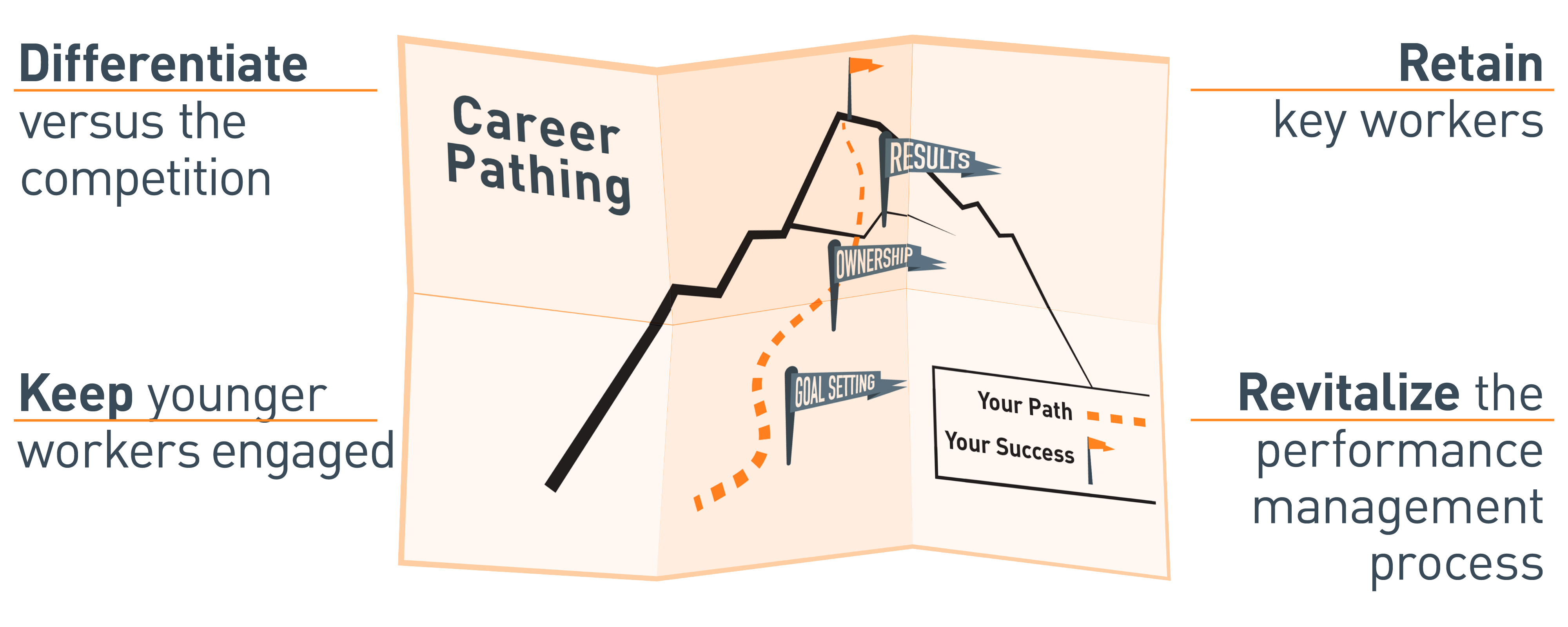Often employees leave their jobs because there is no clear path for them to advance, or they are not sure how to rise to the position they desire. Career pathing is a great way to increase employee retention and grow talent organically, because it provides both employees and employers with a clear roadmap, outlining what it takes for workers to move from their current position to where they want to be. It also empowers employees to take ownership of their career performance within the company and aligns their career goals with the strategic goals of the organization. This not only helps the organization achieve its goals, but also helps the organization in the following ways:

Differentiate the company from competitors. Organizations that do not invest in training and development of their human capital lose valuable candidates to their competition. Employers can effectively differentiate themselves from competitors by investing in their employees’ career development. Even a relatively small employer investment, such as implementing a mentoring program or boosting training opportunities, has a positive impact on loyalty. “Career pathing has great potential as a marketing and branding tool to attract future top talent,” says Nancy Halverson, vice president of franchise engagement and culture for MRINetwork. “When companies are able to share real examples with candidates about how their best employees advanced within the company and how career pathing is a part of the organization’s culture, it provides one more competitive advantage.”
Retain key workers. Many employers in the U.S. are confronting shortages in areas where they most need to attract and retain experienced workers. As a result, they are increasingly concerned about losing high-potential talent. The cost of voluntary turnover can be significant – loss of productivity, lost institutional knowledge and relationships, and added burdens on employees who must pick up the slack.
To prevent this, organizations have to identify workers who are central to the execution of business strategy and then develop or update retention plans to meet the needs and expectations of these employees, particularly those who drive a disproportionate share of key business outcomes or are in short supply in the labor market. Providing identifiable career paths is an important aspect of retention plans, along with coaching and mentoring employees with high potential and moving proven performers into new roles that fit skills developed over time.
Keep younger workers engaged. Employees’ views of work and growth opportunities vary by generation. Millennial workers, for example, value career pathing more than any other generation. In the MRINetwork 2017 Millennial Hiring Trends Study, more than half of Millennials (53 percent) said that career pathing has the most impact on their decision to stay with their employer. This process is not driven by the manager, but with the employee taking charge of their performance review and setting their desired career path. Once goals are set with the manager, successful completion now rests in the employee’s hands. The path is now clear for what they need to do, in order to be promoted or receive a pay increase.
Revitalize the performance management process. As part of the career pathing strategy, the annual review is being reinvented to serve as an efficient, business-focused process that improves employee engagement and drives results. Goals are still agreed upon by employees and managers, but it is incumbent on employees to propel their careers, and manage their performance, not solely the manager. “Annual reviews then become predictable, rather than a guess at how the manager feels the employee performed,” says Anne Hayden, vice president of human resources for MRINetwork. “Ultimately, performance management becomes linked with career pathing as a fundamental component of the company culture.”
Achieving this alignment requires companies to make changes in their performance management process. Getting started requires you to:
- Simplify – get rid of unnecessary, time-consuming, paper-filled steps.
- Ensure that your company’s strategic goals match up with your performance management philosophy.
- Build a new performance management culture that encourages ongoing feedback and continuous development.
- Empower managers to recognize and reward employee performance throughout the year
- Disconnect performance conversations from compensation conversations, which often block an employee’s ability to hear and adopt the feedback that can lead to improved performance.
Career pathing that benefits both the company and its employees requires time and commitment on both parts if it is to succeed in the long term. The payoff for a fully realized process, however, is a happier, more manageable, easier-to-retain workforce because employees who believe their employers make effective use of their talents and abilities are overwhelmingly more committed to staying on the job.
Editorial Contact
Nysha King
Media Relations
Office: 215.282.8821
Email: [email protected]

 Login
Login